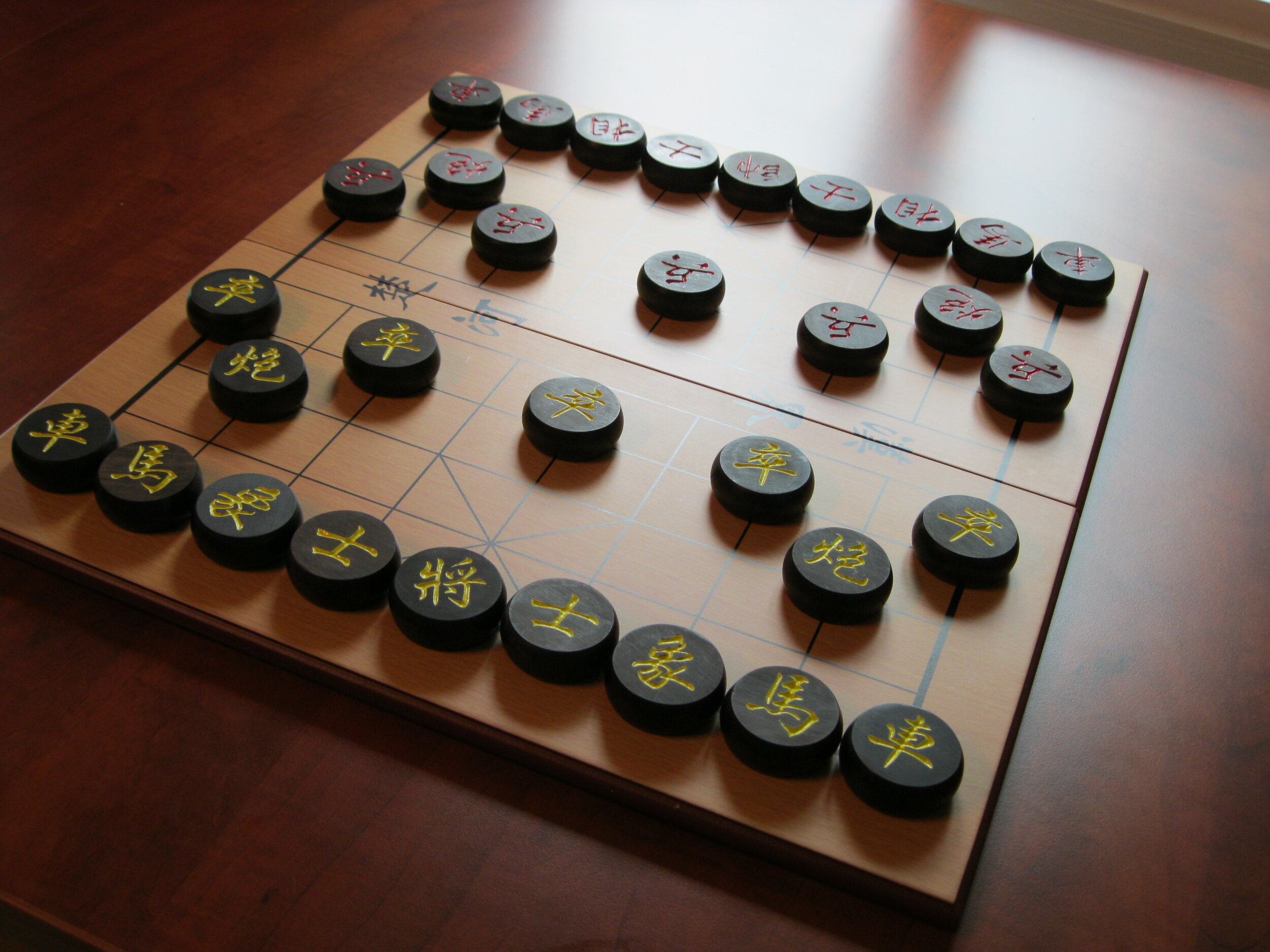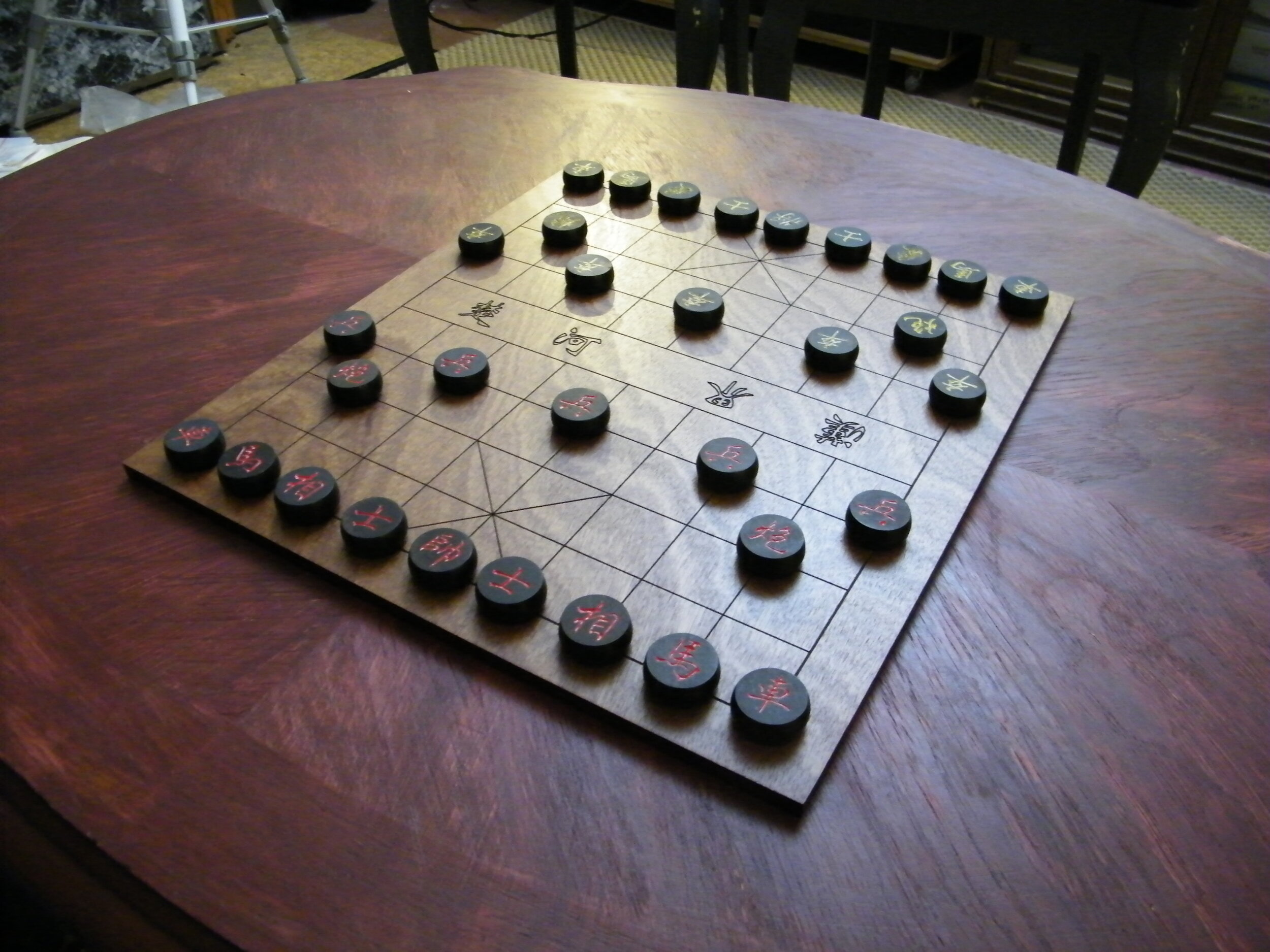A Brief History of the Xiangqi (Chinese Chess) Opening
Author: Jim Png from XqInEnglish
The opening phase in Xiangqi (Chinese Chess) is perhaps the phase that most beginners are interested in learning. Before going into the opening phase details, a summary of the evolution of the Xiangqi opening is mandatory for the player interested in Xiangqi.
The article would be divided into the following sections:
What the ancient manuals have to offer about the opening
Diagram 1 Photography by Rick Knowlton
Song to Ming Dynasty
Xiangqi is believed to have taken its current form after centuries of evolution in the Song Dynasty (960-1279 AD). The ancient Chinese had already expressed much interest in the topic of the opening phase, and there was already a rudimentary Xiangqi opening theory by the Ming Dynasty (1368-1644AD). The ancient manuals must be mentioned here. While historical research has noted the presence of the Xiangqi manuals earlier than the Ming Dynasty, the extant ancient manuals that we can still see today are from the Ming Dynasty or later.
Note: Xiangqi activity went into decline during the Yuan Dynasty (1276-1368AD), and it was basically at a standstill.
Since the Song dynasty, the Central Cannon has been the opening move of choice for Red. Even today, in major tournaments, the Central Cannon is used by Red as the opening of choice in over half of the games played. As for Black, in the early years, Red's Central Cannon would be countered with another Central Cannon of Black's own. If the Cannons played were from the same side of the board, it would be called the Same Direction Cannons. If the Cannons were from opposite flanks, they would be called Opposite Direction Cannons. 1
The Same Direction Cannons and the Opposite Direction Cannons were hallmarks and representative of the romantic style of play in the early years of Xiangqi. There were often gambits early into the opening phase, which were completed with even more bold sacrifices and brilliant kills. Amongst the two, the Same Direction Cannons enjoyed better success and is still commonly played even today. The Opposite Direction Cannons fell out of favor but has been reborn in various counters, whereby Black would defer the move of countering with a Central Cannon a few moves later. The Deferred Opposite Direction Cannons would become a viable counter and, in some Chinese literature, is called the Modern-day Opposite Direction Cannons.
The Secret in the Tangerine (《橘中秘》jú zhōng mì) was the ancient manual that studied the Same Direction Cannons and Opposite Direction Cannons in detail. The interested reader is encouraged to read the translated version of the ancient manual by the author.
Hence, one could say that from the Song dynasty to the Ming dynasty, the Central Cannon was the opening move of choice for both Red and Black. We could see some other openings like the Pawn Opening, the Elephant Opening, the Cross Palace Cannon, the Sandwiched Horse Defense, et cetera in the literature, but the consensus was that they were far inferior to the Central Cannon.
Technically speaking, “ipsilateral” should be the correct word to use instead of “same direction” while “contralateral” should be used instead of “opposite direction”. However, the names were suggested by the AXF/WXF back in the 1980s and represented a simple way for the average player to understand what that opening was mentioned.
Diagram 2 Photography by Rick Knowlton
Qing Dynasty
During the Qing Dynasty (1644-1912AD), Wang Zaiyue came along with his revolutionary Wang's Plum Flower Manual. In the book, the Screen Horse Defense was presented as a viable counter to the Central Cannon. The arrival of the Plum Flower Manual signified another stage in the evolution of the Xiangqi opening. Although the Screen Horse Defense had already been mentioned in the Secret in the Tangerine earlier, Wang Zaiyue is credited to have made the Screen Horse Defense a viable counter. His work revolutionized Xiangqi openings and inspired new ways of playing the opening.
There was much interest in the Central Cannon vs. Screen Horse Defense opening system, and many later ancient manuals expanded Wang's work. For some unknown reason to the author, ancient manuals that studied the opening system were also called Plum Flower Manuals. Wu's Plum Flower Manual focused on a specific variation; the Plum Flower Springs Manual focused on advancing the central Red Pawn, and even Ba Jiren's Anti-Plum Flower Manual, which disputed many of Wang Zaiyue's claims. Wang's work sparked a debate over the past few centuries called the Horse Cannon Debate (炮马争雄 pào mǎ zhēng xióng). Supporters of the Central Cannon felt that the Central Cannon was superior to the Screen Horse Defense, while the Screen Horse Defense advocates thought that the Screen Horses were superior.
Wang Zaiyue's work changed Xiangqi. Even today, in any tournament in modern times, a great percentage of the games (usually over half of the games played) involve the Central Cannon vs. Screen Horse Defense opening system. The Same Direction Cannons and Opposite Direction Cannons slowly fell out of favor, and while they were still played, the Central Cannon and Screen Horse Defense became the opening system of choice.
20th century
In the early twentieth century, there were even more breakthroughs. The width and depth of various significant variations grew, but it was still basically the Central Cannon vs. Screen Horse Defense and the Same Direction Cannons. Some books from this turbulent period (1900-1950s) and modern-day opening theory slowly began to take shape.
In 1956, which most historians designate as the beginning of modern-day Xiangqi, the first-ever Chinese National Xiangqi Individual Championships was held. The event marked a considerable advance in Xiangqi as a whole. In the case of the Xiangqi opening, competitors started exploring new openings and variations. While it took some time to gain momentum, by the 1980s, Xiangqi openings had already reached another stage in the evolution of the Xiangqi opening. Previously condemned openings and counters were given a new lease of life.
In modern-day competition, while the Central Cannon versus the Screen Horse Defense is still the most commonly seen opening system, there are many other opening systems like the Pawn Opening vs. Thundering Defense et cetera, which have gained much popularity. Openings and counters that were previously deemed inappropriate or not viable in ancient times were given a new life as tremendous advances were made in opening theory.
Grandmasters and masters have contributed much to the depth and variety of Xiangqi openings. Amongst them, Grandmaster Hu Ronghua is credited to have revolutionized and made the Elephant Opening a viable choice for Red to start the game. He also refined the Sandwiched Horse Defense to become a plausible counter against the Central Cannon. As China was just opening its doors to the world in the 1980s, GM Hu's Sandwiched Horse Treatise was one of the first books Westerners came into contact with. That would explain the counter's relative popularity, as it was significantly praised in Sam Sloan's book. It is still very often seen in competition to this day.
Another Red opening that became immensely popular in modern-day Xiangqi is the Angel's Pawn. There have been major breakthroughs in this opening as Red, and it has been the favorite opening of choice by many grandmasters and masters alike. For example, grandmasters Hong Zhi, Zheng Weitong are known for their expertise with the opening. Today, the biggest threat to displacing the Central Cannon opening as the opening choice for Red would be the Angel's Pawn or the Elephant opening.
If modern-day Xiangqi openings were compared with their ancient counterparts from the Ming dynasty, one would see that there was a shift in the general strategy. There is more emphasis on the formation of an attack or defense. The word 'formation' can be thought to be similar to the term structure, but it would be a more accurate translation of the Chinese term 阵型 (zhèn xíng). Besides, the term 'structure' would seem to imply Pawn structures in International Chess.
Instead of big and bold attacks and kills, modern-day Xiangqi is more concerned with positional play and emphasized control for most of the variations. There are still variations like the Charging Bull Variation that emphasized a rapid attack by pushing the central Pawn forward very early in the game. Still, generally speaking, most modern-day openings and variations are more subtle and deliberate. Modern-day variations are much more complex and more profound than the variations given in the ancient manuals from the Ming and Qing dynasties. The room for error is also much smaller, and small mistakes are more punishable.
In the twenty-first century, computer programs to help analysis have also rapidly seen an improvement in the Xiangqi opening. Flying daggers (the Xiangqi term for an opening novelty) are seen in every tournament, and there would be counters for the same flying dagger the very next day. (1) (2) (3) (4)
Diagram 3 Photograph by Rick Knowlton
What the ancient manuals have to offer about the opening
Although much of the ancient manuals' advice about various openings would be grossly outdated, it is still mandatory to know the advice for a firm foundation in opening theory.
Listed below are some of the advice, in the form of Chinese poems from the Secret in the Tangerine. The interested reader is recommended to go through the English versions that the author has also translated.
《橘中秘》 - 歌诀
The following is a collection of poems and advice on the opening from the Secret in the Tangerine.
当头炮诀
起炮在中宫,比诸局较雄。(qǐ pào zài zhōng gong, bǐ zhū jú jiào xióng)
马常守中卒,士上将防空。(mǎ cháng shǒu zhōng zú, shì shàng jiàng fang kōng)
象要车相护,卒宜左右攻。(xiàng yào jū xiāng hù, zú yí zuǒ yòu gōng)
若将炮临敌,马出渡河从。(ruò jiàng pào lín dí , mǎ chū dù hé cóng)
Tips for the Central Cannon
Starting with the Central Cannon is better than the other openings.
The Horse(s) would have to protect the central Pawn while the Advisors defend against enemy attacks along the central file.
The Elephants (weaknesses on both flanks) need protection from the Chariots, while the Pawns can be used to attack from both left and right.
If the Cannon is ready to attack the enemy territory, the Horses must follow and cross the river not far behind.
士角炮诀
炮向士角安,车行二路前。(pào xiàng shì jiǎo ān, chē xíng èr lù qián)
过河车炮上,炮又马相连。(guò hé jū pào shàng, pào yòu mǎ xiāng lián)
车先图士象,马将炮向前。(jū xiān tú shì xiàng, mǎ jiāng xiàng qián)
敌人轻不守,捉将有何难。(dí rén qīng bù shǒu, zhuō jiàng yǒu hé nán)
Tips for the Palcorner Cannon
Place the Cannon at the palace corner while the Chariots attack from the external rib files. The Cannon would follow the Cross-River Chariot, and not far behind must the Horses be found (attacking as a Horse-Cannon combination).
The Chariots would try to take out the enemy Advisors and Elephants. The Horse would act as Cannon mount while charging forward, and together, they charge forward.
After cracking open the enemy defense, capturing the enemy king would be an easy task!
飞炮诀
炮起边塞上,翻卒势如飞。(pào qǐ biān sài shàng, fān zú shì rú fēi)
横并当头妙,冲前落角宜。(héng bìng dāng tóu miào, chōng qián luò jiǎo yí)
乘虚士可得,有隙象先图。(chéng xū shì kě dé, yǒu xì xiàng xiān tú)
夹辅须车力,纵横马亦奇。(jiá fǔ xū jū lì, zòng héng mǎ yì qí)
Tips for the Flying Cannon
Start the Cannon on the edge and attack the Pawns for the initiative. With the aid of a Central Cannon, the Edge Cannon could press forward and even occupy the boardcorners. The enemy Advisors would be easy prey, while the enemy Elephants would be easily caught off-guard. For the final onslaught, the Chariots are needed, and the majestic steed may be a surprise.
象局诀
象局势常安,中宫士必鸳。(xiàng júshì cháng ān zhōng/zhòng gōng shì bì yuān)
车先河上立,马在后遮拦。(jū xiān hé shàng lì, mǎ zài hòu zhē lán)
象眼深防塞,中心卒莫前。(xiàng yǎn shēn fáng sāi, zhōng xīn zú mò qián)
势成方动炮,破敌两岸边。(shì chéng fāng dòng pào, pò dí liǎng àn biān)
Tips for the Elephant Opening
The Elephant at the center would guarantee peace, and the Advisors must be linked. The Chariot should assume its position on the riverbank, providing cover for the Horses from behind. Beware of the enemy commanding the Elephant eyes, and the central Pawn should not be charged forward. When all is ready is the Cannon allowed to join in the attack, and the enemy would be defeated from the flanks.
破象局诀
一炮在中宫,鸳鸯马去攻。(yī pào zài zhōng gong, yuan yāng mǎ qù gōng)
一车河上立,中卒向前冲。(yī jū hé shàng lì, zhōng zú xiàng qián chōng)
引车塞象眼,炮在后相从。(yǐn jū sāi xiàng yǎn, pào zài hòu xiāng cóng)
一马换二象,其势必英雄。(yī mǎ huàn èr xiàng, qí shì bì yīng xióng)
Tips for Defeating the Elephant Opening
Place one Cannon on the central file and attack with the centrally linked Horses. A Chariot placed on the riverbank would do wonders, while a central Pawn would rush forward.
Move the Chariot to block the enemy Elephant's eye, and place a Cannon behind (the Chariot).
Use the Horse to trade for the two enemy Elephants, and one would have a position worthy of a hero. (4)
Works Cited
1. Liu 刘Dianzhong 殿中 和 Qi 齐Jin-an 津安. 象棋精编课程--象棋布局精要. 北京 : 北京大学出版社, 2005年 1月. 7-81051-486-5/G.416.
2. Wang 王, Guodong 國棟, Fang 方, Shiqing 士慶 and Li 李, Yangui 燕貴. 跟我學象棋--初級教程 Learn Xiangqi from me -- Basic Syllabus. 成都 : 成都傳媒集團.成都時代出版社, 2007年11月 第二版. 978-7-80705-514-4.
3. Tu 屠, Jingming景明 and Yang 楊, Baiwei 柏偉. 象棋辭典. 上海 : 上海文化出版社, 2009. p. 19.
4. Png, Jim Hau Cheng. Lexicon of Xiangqi (Chinese Chess) Terms in English. Taipei : Jim Png Hau Cheng, 2017. 978-957-43-4707-0.




